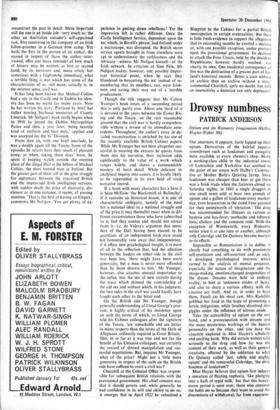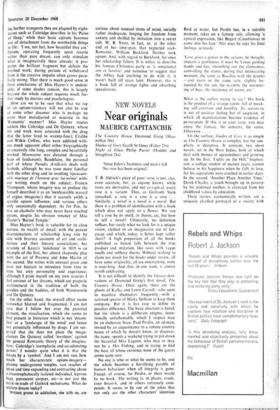Drowsy numbness
PATRICK ANDERSON
Opium and the Romantic Imagination Alethea Hayter (Faber 50s) -
Our ancestors, it appears, fairly lapped up their opium. Derivatives of the baleful• pa paver somniferum such as laudanum and paregoric were available at every chemist's shop. Many a working-class child in the industrial towns of Lancashire and Yorkshire was soothed to the point of no return with Dalby's Carmina- tive or Mother Baily's Quieting Syrup. Since laudanum was cheaper than beer or gin there was a-brisk trade when the factories closed on Saturday nights; in 1843 a single druggist in one small town sold at least two pounds of opium and a gallon of laudanum every market- day; even housewives in the stolid Fens yearned for their pennyworth of 'elevation.' The drug was recommended for illnesses as various as hysteria and hay-fever, toothache and tubercu- losis, cholera and the common cold. With the exception of Wordsworth, every Romantic writer tried it at one time or another, although only Coleridge and De Quincey became martyrs to its effects.
Impossible as Romanticism is to define, it clearly had something to do with passionate self-revelation and self-assertion and, as such, it developed psychological interests which turned to the analysis of mental processes, especially the nature of imagination and the image-making, emotion-charged propensities of the dream. Dreams were held to embody reality, to hint at 'unknown modes of being' and also to share a curious affinity with the creative act itself. And so, in order to have them, Fuseli ate his meat raw, Mrs Radcliffe gobbled her food in the hope of promoting a fertile indigestion, while Southey dissolved into giggles under the influence of nitrous oxide.
Take the accessibility of opium on the one hand, and a preoccupation with dreams and the more mysterious workings of the human personality on the other, and you have the situation explored in Miss Hayter's scholarly and exciting book. Why did certain writers take seriously to the drug and how far was the content of their work, as well as their general creativity, affected by the addiction to what De Quincey called 'just, subtle and mighty opium' and the remorseful Coleridge, 'the dirty business of laudanum'?
Miss Hayter believes that opium first induces a sensation of floating euphoria, 'like plunging into -a bath of tepid milk,' but that this honey- moon period is soon over; those who continue the habit do so because they want to avoid the discomforts of withdrawal; far from experienc- ing further transports they are plagued by night- mares such as Coleridge describes in his 'Pains'• of Sleep,' while their basic atlitude becomes one of detachment from the worthwhile things in life: 'I see, not feel, how beautiful they are.' Opium, operating frequently upon reverie rather than pure dream, can only stimulate what is imaginatively there already; it pro- motes the brilliant fragment but defeats the finished work; during periods of withdrawal from it the creative impulse often grows pecu- liarly strong. That there is much good sense in these conclusions of Miss Hayter's is undeni- able; if some doubts remain, this is largely because the whole subject requires much fur- ther study by doctors and psychologists.
How are we to be sure that what we say of an opium-visionary will not also be true of some other dreamer who is perhaps no more than maladjusted or neurotic in the 'Romantic' manner? Miss Hayter studies addicts like Coleridge and De Quincey, whose life and work were saturated with the drug (but the latter lived to seventy-four); Crabbe and Wilkie Collins, who were addicted with- out much apparent effect either biographically or creatively (the long, complex and beautifully worked Moonstone was dictated through a haze of laudanum); Baudelaire, the personal part of whose Paradis A rtificiels .deals with hashish, although he was even more familiar with the other drug and its resulting 'epouvant- able mariage de l'homme avec lui-meme' with- out writing much on the subject; Francis Thompson, whose imagery was so profuse (he himself described it as an 'inexhaustible wassail of orgiac imageries') that it scarcely yields a specific opium influence; and various others only occasionally dependent. As for Poe, he was an alcoholic who may never have touched opium, despite his obvious tenancy of Miss Hayter's 'Buried Temple.'
Miss Hayter's book is valuable for its close texture, its wealth of detail, with the patient discriminations of scholarship lying side by side with bravura accounts of art .and archi- tecture and their literary associations; her scrutiny of Keats's 'indolence' in 1819 is an example of the first, her almost rhapsodic play with the art of Piranesi and John Martin of the second. She writes with unusual grace and does not hesitate to introduce from time to time her own personality and experience; although I pride myself on my own reveries I feel envious of her dreams, which are properly architectural in the tradition of both the goodies and the baddies, of both Wordsworth and De Quincey.
On the other hand, the overall effect seems somewhat blurred and fragmented. I am not sure that I follow her over the pictorial element, the visualisation, which she seems to find present in literature which is not 'dream- like' or a 'landscape of the mind' and hence not potentially influenced by drugs. I am sur- prised that she does not place the image- clusters De Quincey called 'involutes' against the general Romantic theory of the imagina- tion: Coleridge's 'esemplastic and co-adunating Power.' I wonder quite what it is that she means by a 'symbol.' And I am not sure how much her characteristic opium-imagery- gloomy underground temples, vast reaches of space and time expanding and contracting about a claustrophobically isolated individual, leprous hags, putrescent corpses, etc—is not just the stock-in-trade of Gothick melodrama. What do addicts dream today?
Writers prone to addiction, she tells us,. are
curious about unusual states of mind, socially rather inadequate, longing for freedom from anxiety and thrilled by initiation into a secret cult. W. B. Yeats, in fact, or, at the other end of her time-span, that neglected arch- Romantic, William Beckford. Neither took opium. And, with regard to Beckford, for once her scholarship falters. It is unfair to describe his famous Christmas party as 'a sensational son et Ituniere' and nonsense to suggest that the Abbey had anything to do with it; it wasn't built till years later. However, this is a book full of strange lights and absorbing speculations.



































 Previous page
Previous page